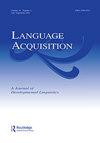Smashing verb learning through parental sound symbolic input in preterm and full-term children
IF 1.3
3区 文学
0 LANGUAGE & LINGUISTICS
引用次数: 0
Abstract
ABSTRACTSound symbolism, the iconic link between speech sounds and meanings, helps children’s verb learning. In sound symbolically rich languages such as Turkish, hearing sound symbolic words might facilitate early verb learning and later language-specific expressions of motion events, by providing an easier way to map verbs onto events. These links could be much stronger for children who had difficulties in word-referent mapping (e.g., preterm children). The current study examined the association of Turkish-speaking parents’ sound symbolic input at 20 months with children’s concurrent verb knowledge and later motion event descriptions at 48 months. Ninety-one parent-infant dyads (Mage = 19.92 months, SD = 1.38; 41 preterms) were observed at 20 months, where we measured sound symbolic input and verb knowledge. Sixty-four of these dyads participated in a motion event description task at 48 months (25 preterms, Mage = 48.79 months, SD = 1.68), where we coded how children use path (the trajectory of motion) and manner (how an action is performed) of a motion. Results from the robust regression models suggested that for preterm children, parents’ sound symbolic input used in adverb forms was positively and concurrently related to children’s verb knowledge. Only for full-term children, sound symbolic input (used as adverbs) predicted full-term children’s use of both path and manner information in their descriptions at 48 months. Lack of replication of these findings with outlier-removed analyses could only suggest a trend toward the differential contributions of sound symbolic input in different child populations and the importance of sentential cues in sound symbolic input in verb learning. AcknowledgmentsWe thank everyone in the Language and Cognition Lab and Language and Communication Development Lab at Koç University for their valuable feedback for this research. We appreciate the efforts of Işıl Doğan, Aslı Aktan-Erciyes, and Salih Özdemir for this project. We especially thank Işıl Doğan, Nurgül Arslan, Nurdem Okur, and Süeda Vardar for data collection, Cansu Kılıç for data coding, and the families who participated in our study. Special thanks to Metin Sabancı Healthcare Center for Family Counseling for the institutional support, Prof. İpek Akman for her continuous help in the project, Dr. Nihan Hande Akçakaya, Banu Bingöl, and Rahime Gökboğa from Metin Sabancı Healthcare Center to their support for the project, El Bebek Gül Bebek Foundation for Premature Birth and Gymboree Classes for helping us reach out the families.Disclosure statementThe authors report there are no competing interests to declare.Data availability statementThe data used in this study can be accessed from https://osf.io/74ftz/?view_only=2a2bf3c235b04c1da5dace95e1b3d616Notes1 The sound symbolic input data of 34 FT children were also used in Kızıldere et al. (Citation2022).2 Parental education had three levels: not holding a college degree, holding a college degree or equivalent, and holding a graduate degree.3 The performance of children who participated in the study via computer did not differ from the performance of children who did not participate in the study via computer in the motion event description task, Path Any: t(62) = -1.426, p = .159, Manner Any: t(62) = 1.570, p = .122, Path + Manner: t(62) = .854, p = .397.4 Fifty-eight children were with their parents while six children were alone during the procedure alone. Participating alone or with a parent was not associated with children’s performance in the motion event description task: Path Any: t(62) = .088, p = .930, Manner Any: t(62) = .034, p = .973, Path + Manner: t(62) = -.049, p = .961.5 To indicate the specific importance of adverbial use of sound symbolism, we also tested the model with sound symbolic input used in verb-related roles (Verb, Auxiliary Verb, Adverb). Results indicated neither a significant main effect (B = 8.50, SE = 5.48, p = .125), nor an interaction with neonatal condition (B = -17.72, SE = 11.62, p = .131).6 The interaction between sound symbolic input used in verb-related roles (Verb, Auxiliary Verb, Adverb) and neonatal condition, was also a significant predictor of Path + Manner (B = .128, SE = .047, p = .009).7 Since maternal education differed across PT and FT children, we also ran all models reported in this paper including maternal education as a control variable. The results from the models with maternal education was not substantially different than the results of the reported models..Additional informationFundingThis work was supported by the James S. McDonnell Foundation Scholar Award (Grant no: https://doi.org/10.37717/220020510) to Tilbe Göksun.通过父母声音符号输入对早产儿和足月儿童动词学习的影响
摘要语音符号是连接语音和意义的符号,有助于儿童动词的学习。在像土耳其语这样声音符号丰富的语言中,通过提供一种更简单的方法将动词映射到事件上,听到声音符号词可能有助于早期的动词学习和后来的运动事件的语言特定表达。这些联系对于那些在单词参照映射方面有困难的儿童(例如,早产儿)来说可能会更强。本研究考察了土耳其语父母在20个月时的声音符号输入与孩子在48个月时并发动词知识和后来的动作事件描述的关系。91例亲子对(Mage = 19.92个月,SD = 1.38;41个早产儿)在20个月时观察,我们测量了声音符号输入和动词知识。其中64对在48个月大时(25个早产儿,Mage = 48.79个月,SD = 1.68)参与了运动事件描述任务,我们对儿童如何使用运动路径(运动轨迹)和方式(如何执行动作)进行编码。稳健回归模型的结果表明,父母在副词形式中使用的语音符号输入与儿童的动词知识呈正相关。仅在足月儿童中,声音符号输入(用作副词)预测了足月儿童在48个月时对路径和方式信息的描述。通过剔除异常值的分析,缺乏对这些研究结果的重复,只能表明不同儿童群体的声音符号输入的差异贡献和句子线索在动词学习中声音符号输入的重要性的趋势。我们感谢Koç大学语言与认知实验室和语言与交流发展实验室的每个人对这项研究的宝贵反馈。我们感谢Işıl Doğan、aslila Aktan-Erciyes和Salih Özdemir为这个项目所做的努力。我们特别感谢Işıl Doğan、nurg l Arslan、Nurdem Okur和seda Vardar收集数据,感谢Cansu Kılıç进行数据编码,感谢参与我们研究的家庭。特别感谢Metin sabancyi家庭咨询医疗中心的机构支持,İpek Akman教授对项目的持续帮助,Metin sabancyi医疗中心的Nihan Hande akakakakaya博士,Banu Bingöl和Rahime Gökboğa对项目的支持,El Bebek基金会 l Bebek早产基金会和金宝贝班帮助我们接触到家庭。作者报告无利益竞争需要申报。数据可用性声明本研究使用的数据可从https://osf.io/74ftz/?view_only=2a2bf3c235b04c1da5dace95e1b3d616Notes1获取,34名FT儿童的声音符号输入数据也被Kızıldere等人使用(Citation2022).2父母的教育有三个层次:没有大学学历,有大学学历或同等学历,有研究生学历通过计算机参与研究的儿童在运动事件描述任务中的表现与没有通过计算机参与研究的儿童没有差异,Path Any: t(62) = -1.426, p = .159, Manner Any: t(62) = 1.570, p = .122, Path + Manner: t(62) = .854, p = .397.4在单独的过程中,58名儿童与父母在一起,6名儿童独自一人。单独参与或与父母一起参与与儿童在动作事件描述任务中的表现无关:Path Any: t(62) = 0.088, p = 0.930, Manner Any: t(62) = 0.034, p = 0.973, Path + Manner: t(62) = -。049, p = .961.5为了表明语音符号在副词使用中的特殊重要性,我们还测试了在动词相关角色(动词、助动词、副词)中使用语音符号输入的模型。结果显示,无显著主效应(B = 8.50, SE = 5.48, p = 0.125),与新生儿状况无交互作用(B = -17.72, SE = 11.62, p = 0.131)在动词相关角色(动词、助动词、副词)中使用的声音符号输入与新生儿状况之间的交互作用,也是Path + Manner的显著预测因子(B = .128, SE = .047, p = .009)由于PT和FT儿童的母亲教育不同,我们也运行了本文报道的所有模型,其中包括母亲教育作为控制变量。有母亲教育的模型的结果与报道的模型的结果没有本质上的不同。附加信息资金本研究得到了James S. McDonnell基金会学者奖(资助号:https://doi.org/10.37717/220020510)对Tilbe Göksun的支持。
本文章由计算机程序翻译,如有差异,请以英文原文为准。
求助全文
约1分钟内获得全文
求助全文
来源期刊

Language Acquisition
Multiple-
CiteScore
2.30
自引率
8.30%
发文量
20
期刊介绍:
The research published in Language Acquisition: A Journal of Developmental Linguistics makes a clear contribution to linguistic theory by increasing our understanding of how language is acquired. The journal focuses on the acquisition of syntax, semantics, phonology, and morphology, and considers theoretical, experimental, and computational perspectives. Coverage includes solutions to the logical problem of language acquisition, as it arises for particular grammatical proposals; discussion of acquisition data relevant to current linguistic questions; and perspectives derived from theory-driven studies of second language acquisition, language-impaired speakers, and other domains of cognition.
 求助内容:
求助内容: 应助结果提醒方式:
应助结果提醒方式:


